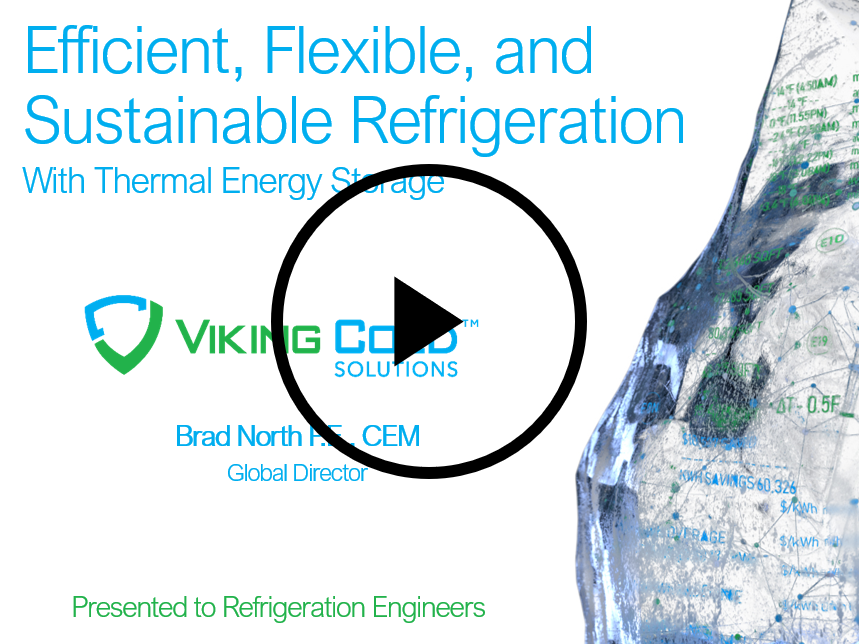
Brad begins his presentation with relevant cold chain statistics about facilities where refrigeration optimization with intelligent Thermal Energy Storage is being achieved by leveraging PCM. He also explains some of the unique thermodynamic properties of PCM that allow TES systems to achieve positive refrigeration energy and temperature management results. He then covers how the PCM is configured and easily installed into various cold storage refrigerated facilities without additional space requirements or the loss of valuable storage area.
Also covered in the presentation is a brief evolutionary history of the refrigeration practice known as flywheeling – subcooling the food and surrounding room to then minimize refrigeration during periods with high energy costs. Brad discusses factors that influenced the start of flywheeling, are transforming flywheeling practices with new technologies, as well as how PCM safely extends the length of flywheeling periods while reducing the risk to food quality and shelf life. He also shares how PCM is able to slow temperature increases in a room without active refrigeration and shows case study data illustrating a reduced rate-of-rise and improved temperature stability.
Inside cold storage facilities temperature stratification throughout the room generally occurs. Brad shows some examples of how properly installed PCM combined with intelligence reduces the extent of temperature stratification and creates a more uniform temperature across the vertical space of these refrigerated rooms. With the introduction of PCM a new “stratification floor” is created that consolidates more of the heat near the ceiling in the airflow of the evaporators for improved temperatures around the food and for easy removal of the heat by the refrigeration system.
Thermal Energy Storage is often considered a way to simply shift when energy is consumed by refrigeration systems. Brad explains many of the factors that allow Viking Cold’s TES technology to not only shift the timing of refrigeration but also to safely reduce the total kWh energy consumption (energy efficiency) of the refrigeration systems. Hear about the factors that enable this such as reducing the horsepower per ton ratio, the ability to run refrigeration systems at maximum designed efficiency or “fully loaded”, the consolidation of up to 85% of the heat infiltration near the top of the room, the PCM’s higher heat capacity and heat transfer rates, and the fact that TES systems do not have mechanical components that cannibalize the energy savings with parasitic losses.
Also discussed in this refrigeration engineer’s presentation are additional attributes of TES that provide energy flexibility and the ability to safely and easily participate in multiple utility and grid operator programs. Many of these programs reduce costs, some provide financial incentives for technology upgrades, and some programs can generate revenue streams for operators of refrigerated facilities. The added refrigeration flexibility from TES enables participation in programs such as demand response, permanent load shed, targeted load shed, peak shaving, responding to market index pricing signals, renewables plus storage, and capacity programs.
Temperature resiliency inside the refrigerated cold chain is paramount to maintaining food quality and shelf life while minimizing food loss. Brad also explains how PCM adds resiliency to cold storage rooms. Common scenarios that disrupt cold storage operations and create a need for temperature resiliency are becoming more common and include mechanical breakdown of refrigeration system components and loss of power from ice storms, hurricanes, wildfires, utility-initiated de-energization, and more. Refrigerated facilities that have TES installed have up to three times longer temperature protection during any of these situations that may cause the loss of refrigeration.
Whether you are a facilities or business leader, refrigeration engineer, cold storage operator, or somewhere in the temperature-controlled cold chain, there is something in this short professional association presentation for you. Quickly learn about mitigating risk, cutting costs, improving sustainability, stabilizing temperatures, and more.
Click above to watch this short 21-minute refrigeration engineer professional association presentation. Or contact us today to learn how our refrigeration optimization and thermal energy storage solutions will save you energy and money.
